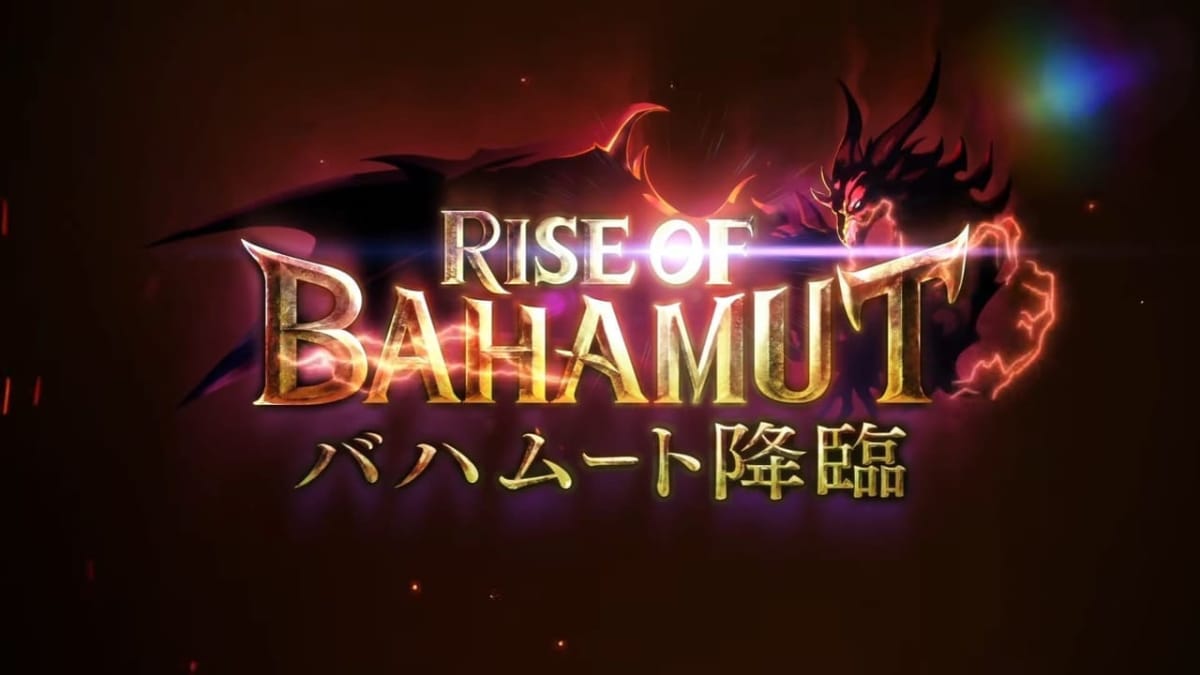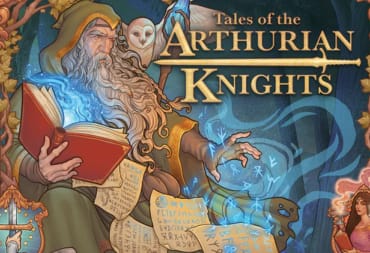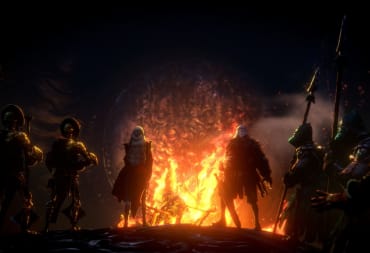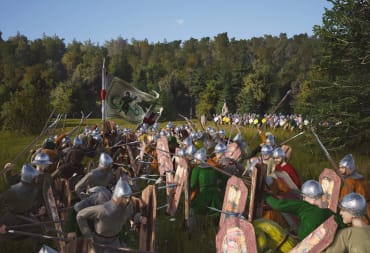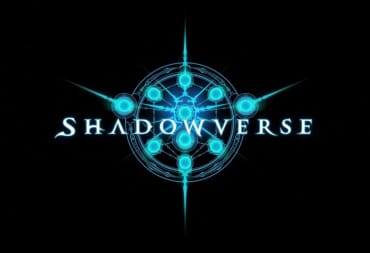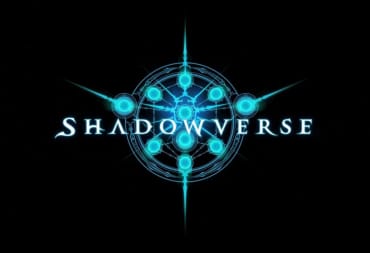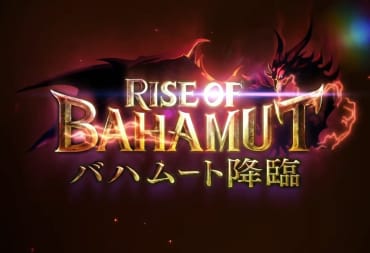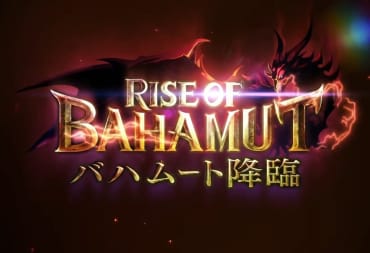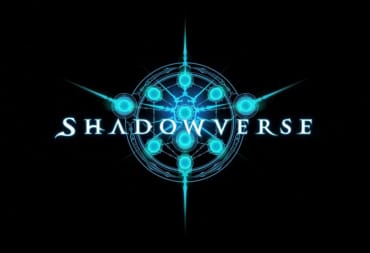Shadowverse is a card game by Cygames available on mobile devices and Steam. Though new, it has received raving reviews and is currently in the process of establishing their second expansion, Rise of Bahamut. Want to try the game out? Check out our Shadowverse Competitive Primer series to learn how to get started in Shadowverse! Additionally, the first five card reveal analyses for Shadowverse Rise of Bahamut can be found here, here, here, here and here.
Even more cards were revealed over the last week through the official Shadowverse Twitter and can also be found on the Shadowverse website. This particular set of cards, from the week of December 12th to December 23rd like the last batch, contains a lot of what, at first, seems like power creep. Many of these cards have very strong effects, though whether these effects are worth the costs is not yet clear. The fourth paragraph of each review is a summary of the review.
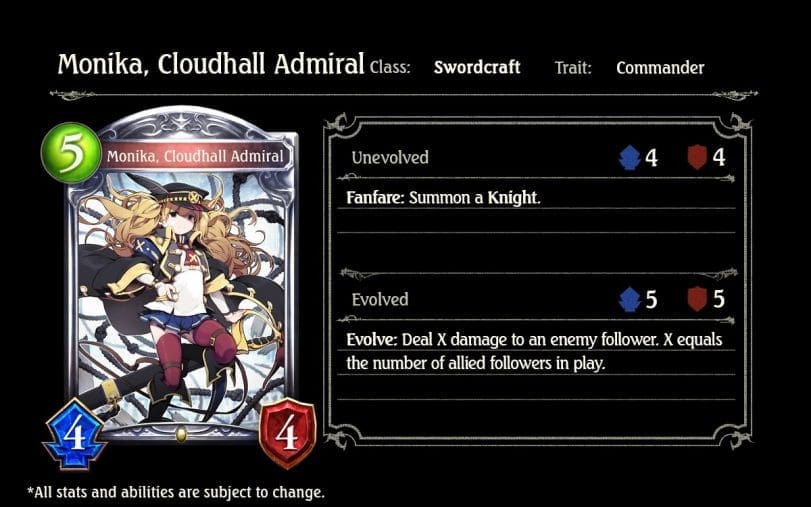
Five points for a 4/4 is standard in Swordcraft, though Monika, Cloudhall Admiral, comes with a 1/1 Knight which technically makes her a five point 5/5. While this is superior in stats to other common Swordcraft five point plays, such as Wind God, Assault Commander, Aurelia, Regal Saber and Avant Blader, the stat boosting effects of the first three and the deck searching effects of the third can potentially provide more value. However, Monika also provides an Evolve effect, so far the only Swordcraft specific five point follower with an Evolve effect. The Rise of Bahamut also introduces the neutral Fortunehunter Feena (review here) which offers a powerful five point Evolve effect follower for all classes.
Monika provides a different effect, however, dealing an amount of damage equal to the amount of followers in play. With just this card and the summoned Knight in play, this is very similar to Goblinbreaker Teena's Evolve ability (review here), dealing two damage to an opposing follower. This seems somewhat underwhelming at first, but Swordcraft's ability to maintain a significant board presence means that the Monika will no doubt be dealing more damage, around three to five. This is enough damage to destroy most turn four follower plays, letting this card switch momentum from one side of the board to the other by establishing a significant board presence at the same time.
Monika's effect fits best in Swordcraft decks that can achieve and maintain control of the board. While aggressive decks can achieve this, they might prefer the immediate damage boosts fro Wind God and Assault Commander. Monika does face competition from Aurelia in terms of reclaiming the board, but Monika offers a far more active and direct way of doing so, while establishing an arguably more threatening presence. Monika, Cloudhall Admiral will no doubt be an important five point play especially in control Swordcraft decks because she can actively reclaim the board with the Fanfare and Evolve abilities.
Summary: Monika already offers good value in stats, though she doesn't boast as much direct offensive presence on a board as some other five point Swordcraft plays do. However, she does offer a valuable five point Evolve effect that is heavily geared towards enforcing board control, allowing her to take an active step in claiming a lead for Swordcraft on turn five.
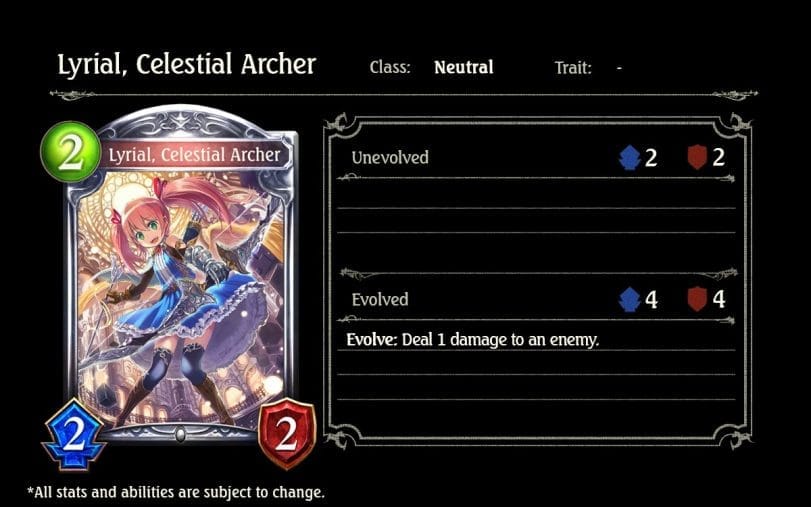
Two points for a 2/2 is absolutely average, but average doesn't necessarily cut it for a neutral card when class specific cards can offer very specific benefits. Lyrial, Celestial Archer is interesting because it is a two point follower with an Evolve effect, meaning Lyrial isn't better than most plays before, at least, turn four. The Evolve effect is very basic, two, an unconditional one damage anywhere on the opposing board, though it is important to note that, despite having an Evolve effect, Lyrial still gains the +2/+2 stats from Evolving, whereas many other Evolve followers only gain +1/+1 or nothing at all.
This card definitely seems geared towards fitting in an aggressive deck. Control decks far prefer to play Evolve followers with more value than Lyrial offers, which includes most four point Evolve followers, such as Dragon Warrior, Priest of the Cudgel and Floral Fencer. Aggressive decks, however, usually prefer to Evolve to push an extra two damage to the opposing leader, and Lyrial can potentially take this one step further by adding in an extra one damage. One damage can be very significant and Lyrial's two point cost means, on turn four, this card can also be comboed with two point followers that gain stats when an Evolved ally is on the board such as Dark Conjurer and Heavenly Hound.
The Evolve effect could also be used to enforce board control, but control decks have many better options and aggressive decks would only do it when absolutely necessary. This card may find it hard to fit into aggressive Havencraft decks, however, which mostly focus on using Storm followers and aggressive Bloodcraft decks which have an almost completely superior option in Vania, Vampire Princess. Lyrial, Celestial Archer is a neutral two point follower that can push more damage in aggressively oriented decks, but it may not be worth running when many decks already have a crowded two point slot and more specialized options.
Summary: Lyrial, Celestial Archer is acceptable stat wise and offers an interesting Evolve effect as a two point follower. While the effect seems geared towards fitting in aggressive decks, especially as she still gains full stat boosts from Evolve, she may not be worth running over class-specific cards that often take advantage of class-specific mechanics to more significant effect.
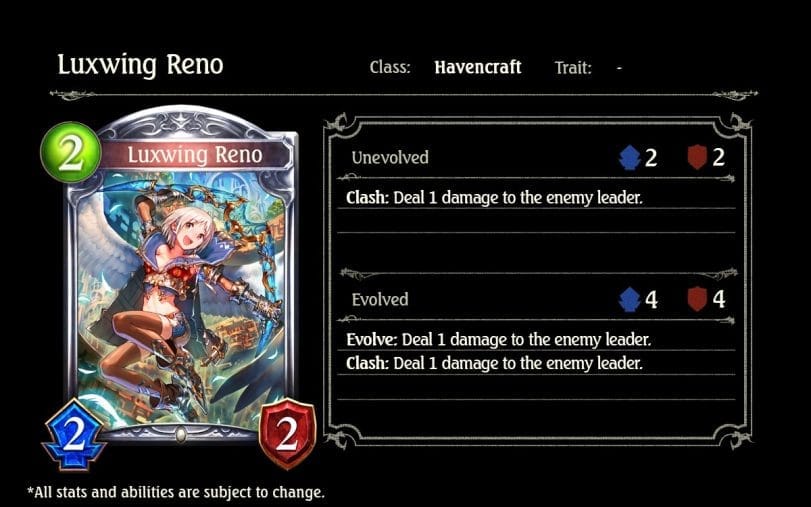
2/2 stats is the absolute standard for two point plays, and Luxwing Reno is no exception. Compared to many Havencraft two point plays, such as Beastcall Aria, Mainyu, Snake Priest and Rabbit Healer, Luxwing Reno is more geared towards having an immediate aggressive presence on the board. The closest comparison is Mainyu, who is difficult to remove especially if played on the second turn of the player going first. Luxwing Reno is more susceptible to removal, but deals one more damage if it gets an attack in. Additionally, if Evolved, it deals an extra one damage to the opposing leader.
While aggressive Havencraft decks mostly focus on comboing Storm followers from their amulets with cards such as Urd and Winged Sentinel Garuda for up to eleven damage on turn six, establishing prior damage to get an opponent into lethal range is always important. A turn two Mainyu is a nearly guaranteed two damage to the leader, but if Luxwing Reno can avoid being taken down by the likes of Sylvan Justice, Undying Resentment and Blackened Scripture, it can deal a very important one more damage. Additionally, on turn four and later, Luxwing Reno can be Evolved to deal a guaranteed two damage to the opponent, which is equal to Evolving a Storm follower to gain two attack and deal damage, but Luxwing Reno can still take advantage of the two attack boost, especially if it was on the field already.
Luxwing Reno really only seems to fit into aggressive Havencraft decks, as the damage to face is not as significant in decks with late game win conditions such as Enstatued Seraph. Aggressive Havencraft decks, while very powerful, do have to find a fine balance between defending themselves against faster aggressive decks and having enough damage to avoid being outvalued by slower control decks, and Luxwing Reno lends all its power to the latter scenario. Aggressive Havencraft always appreciates more options, however, and Luxwing Reno is definitely a viable replacement or companion to Mainyu for early game damage and board control.
Summary: Luxwing Reno faces competition from Mainyu to fit in an aggressive Havencraft deck, the main deck type that this card is geared towards, but offers important additional damage. Though it may not be as reliable as Mainyu in getting damage in, especially in games where the player goes first, it definitely offers enough to make it a serious contender for a place in the archetype.
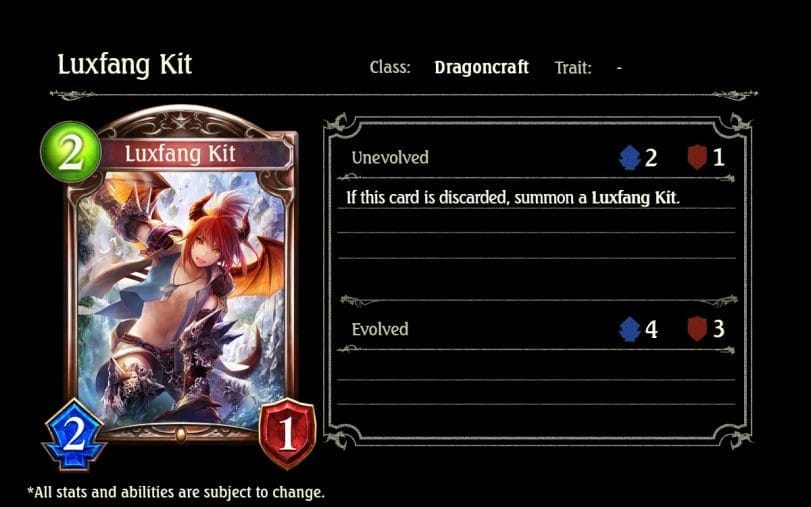
Two points for a 2/1 is below average in a bad way, as a one defense follower can easily be taken down by a one attack one point follower or even something like Elf Child May. Admittedly, Dragoncraft does have a somewhat commonly played two point 2/1, Fire Lizard, but that provides an extra one damage to the opponent's followers, an important way to maintain early game board control. Dragoncraft has quite a few solid two point plays as well, including Dragonrider, Dragon Oracle, Mushussu, Dragon Emissary and, for discard focused Dragoncraft decks, Dragonewt Scholar and Wildfang Dragonewt.
Luxfang Kit is also meant to fit into discard focused decks, as its redeeming quality is its ability, which summons a copy of it when it is discarded. This means that it does contribute to Shadow count and therefore towards Path to Purgatory, though a Path to Purgatory Dragoncraft deck is still dubious. More importantly, Luxfang Kit provides a way for Dragoncraft decks to get "free" board presence off of discards. This card synergizes especially well with Dragonewt Scholar, Dragonewt Fist, Dragon Counsel and Shenlong, as they discard the lowest cost card in the hand, which, given Luxfang Kit's low cost, makes it a common target.
Discard Dragoncraft's multiple early game cycling mechanisms definitely make this a viable way for them to maintain board presence. Though Luxfang Kit's stats are bad, its low cost and discard effect means that this will often be a free 2/1, which is somewhat offensively threatening and helps discard Dragoncraft establish itself more firmly as an aggressive deck.
Summary: Luxfang Kit has bad stats but isn't actually meant to be played as a two point drop. Rather, it takes advantage of Dragoncraft's "lowest cost card"-targeting discard mechanism to freely establish a 2/1 on the board and threaten the opposing leader directly.
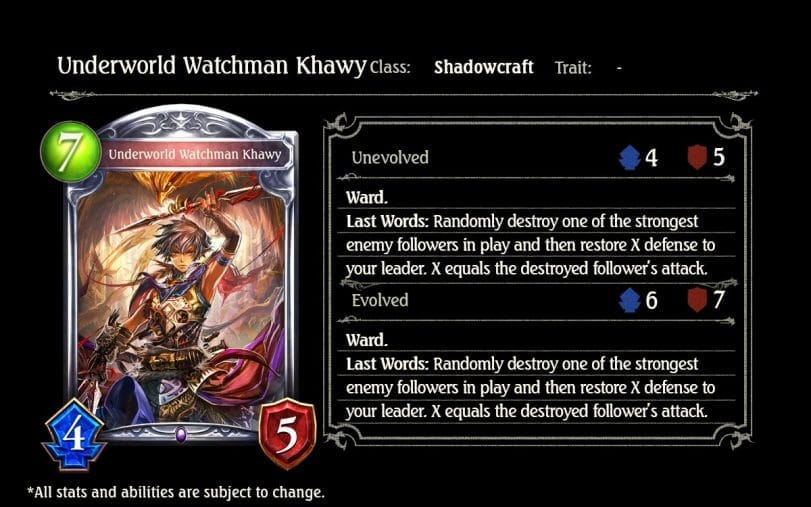
While seven points for a 4/5 is bad, Shadowcraft-specific seven point drops have similarly inferior stats, outside of the never played Orcus, though they have compensation mechanisms. The most well known Shadowcraft seven point play, Lord of the Flies, is only 4/4 but summons with it a 2/3, a 3/2, or a 4/4, all with varying effects. Underworld Watchman Khawy makes up for his bad stats not with more stats, but with a powerful Last Words removal effect and healing. This, combined with his Ward, make Khawy a solid late-game play to cement a lead versus aggressive decks.
Khawy's low stats are a blessing in disguise. Though it might be better for a Ward to have higher defense, Khawy's Last Words is so good that one might want him to go down as soon as possible. Khawy's defense means that he avoids many Havencraft specific banishes such as Blackened Scripture and Priest of the Cudgel, at least before he takes damage. While his cost does place him unfortunately close to the turn where Odin can banish him, drawing that banish is helpful in itself. If Khawy's Last Words do indeed activate, it's difficult to imagine a bad scenario. At minimum, Khawy is a one to one trade, though, especially if Evolved, he could be a two for one or more, as he will take down the attacker and one other with his Last Words. Compared to the very value-heavy Lord of the Flies, Khawy offers a more reliable though less powerful seven point play, especially when struggling to recover against aggressive decks around turn seven.
This card also combos well with the recently revealed Nephthys (review here) with Lurching Corpse (review here), as, if Nephthys manages to pull them both, it will remove two followers on the opposing board as well as heal the player. Depending on which effect activates first on which enemy, they may clash a little, but helping Nephthys come in with a psuedo-board-clear is still a powerful effect. Underworld Watchman Khawy is a reliable, strong seven point play that potentially synergizes with a future last words focused Shadowcraft deck, involving Nephthys.
Summary: Compared to Lord of the Flies, Underworld Watchman Khawy offers far less value but far more direct strength. Khawy is almost a guaranteed one to one and will often trade two for one while healing for a good amount late-game. Additionally, Khawy may find his way into Nephthys Last Word decks in the future.
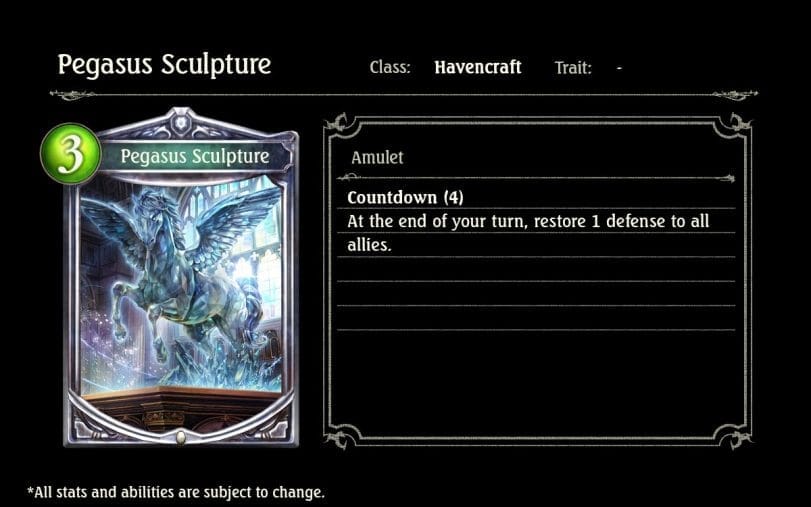
Havencraft's three point plays are quite crowded. Healing Prayer, Divine Birdsong, Temple Defender, Prism Priestess and Elana's Prayer all come to mind. Pegasus Statue is obviously built to fit into Elana's Prayer decks, as restoring one defense with a four turn delay is usually both unpredictable and not worth the hassle, especially for a surprisingly expensive three points. The delay on countdown amulets is supposed to give them more value, not less, and yet this card's effect is directly outclassed by the two point Love's Gospel.
The only benefit that comes to mind given the long countdown and very minor heal is stacking Elana's Prayer buffs. Playing a delayed heal makes it slightly easier to establish a board presence for the buffs to stack on, though this amulet itself takes up one space and, most of the time, Havencraft has no trouble setting up a full board with its countdown amulet summons anyways. Stacking heals to buff followers up to ridiculous levels is not too difficult either, given that there are many cheap heals in cards such as Love's Gospel, Monastic Holy Water and Rabbit Healer.
It's difficult to imagine where this card might fit in. Not only is the heal insignificant, the high delay and awkwardly high cost make it difficult to justify using this card. With the amount of cheap heals that Havencraft already has, it's hard to imagine why one would use this even in an Elana's Prayer deck. Pegasus Statue will probably see almost no play, as it provides almost no benefit due to its long delay and small heal.
Summary: Though this card could give the equivalent of +3/+3 to a full board with Elana's Haven on it without spending any points on that specific turn, Elana's Prayer decks hardly need the extra stats, as, by that time, they are usually threatening enough. Pegasus Statue's functionality is further decreased when one realizes how many other cheap heals are available to trigger Elana's Prayer, especially Love's Gospel, which provides a better effect than this, without delay, for less cost.
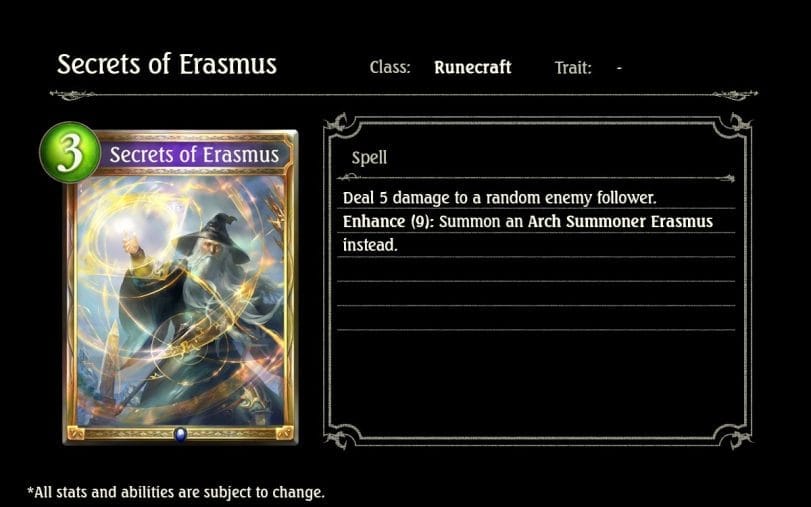
Without looking at the Enhance effect, this card is somewhat mediocre. Granted, it is always better than Surefire Bullet, but that doesn't mean much considering Surefire Bullet is almost never played. It also faces direct competition from Witchbolt, which does one less damage but also has a potentially useful additional effect; this one damage also may not matter much if the cards are played on turn three to four, depending on the situation. Other solid three point cards for Runecraft include Petrification, Summon Snow, Sorcery Cache, Summon Iceform and, for Earth Rite based decks Elementary Alchemy and Price of Magic.
Among this massive variety of various removal and utility effects, Secrets of Erasmus struggles to stand out. The most obvious difference is its Enhance effect, which simply summons an Arch Summoner Erasmus, an eight point follower, for nine points. This already seems like quite a bad deal, especially considering that Erasmus is not run in current viable Runecraft archetypes, perhaps due to its bad stats and randomness. The only reason a player would pay one point more than the actual follower cost just to summon the same follower would be because this card counts as a spell for Spellboosting purposes. Considering the costs, this card is technically a one point spell, which Runecraft enjoys running in Spellboosting decks to Spellboost more rapidly.
Unfortunately, that effect does not redeem this card. By turn nine, current Spellboost archetypes can usually end the game already, and, no matter how cheap this spell technically is, Arch Summoner Erasmus is not worth the point value. As a three point play, this card may be slightly useful as it deals the most follower damage of all three point spells, but three points is a little expensive for a very mundane effect. While Secrets of Erasmus does offer a strong, reliable follower removal effect, especially in the early game, its bad Enhance effect and one-purpose effect means it may not fit in Runecraft decks that rely on cheaper spells and more versatility to survive to a late game finish.
Summary: Runes of Erasmus has a bad Enhance effect that counts as a Spellboost but is one point more expensive than actually playing Arch Summoner Erasmus itself, not even considering that Arch Summoner Erasmus is bad by itself. While the base effect of Secrets of Erasmus deals the highest follower specific damage for its cost, that effect is restrictive and the card itself is a little too expensive to be worth running.
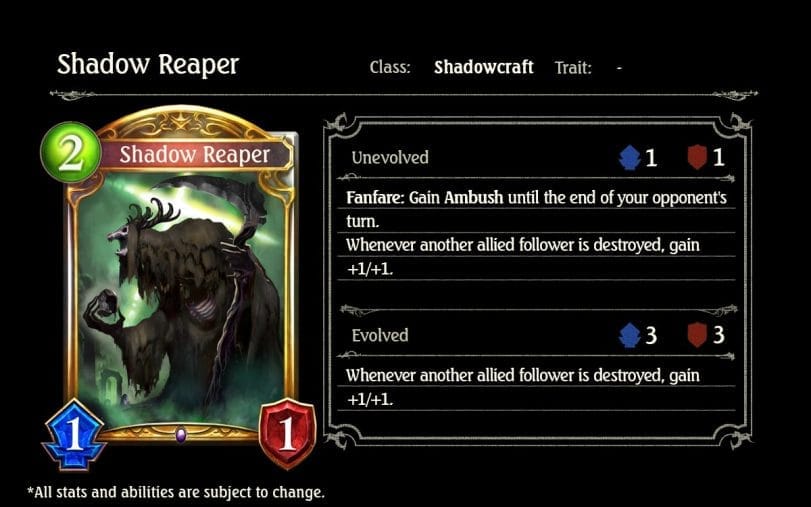
Two point 1/1s are rare, though not unplayed. Still, a two point play that can be traded into by many one point 1/2s requires a good effect to justify its use, as losing that kind of ground early game is a risky proposition. Shadow Reaper is almost guaranteed to survive the first turn out due to Ambush keeping it safe from targeting spells and attacks, though it does fall to the three point Angelic Barrage. On top of this Ambush, Shadow Reaper has the potential to be as big as a 3/3 or a 4/4, thanks to its effect, which allows it to gain +1/+1 every time an allied follower is destroyed. Compared to other common Shadowcraft two point plays, such as Lesser Mummy, Spartoi Sergeant, Dark Conjurer, Skullcradle Widow and Undying Resentment, this card offers potentially greater yields in terms of stats.
This effect is quite unique and does combo well with its one turn Ambush, letting it collect buffs the turn after its played. This card probably fits best in an aggressive Shadowcraft deck best, since the Ambush almost guarantees it an attack and control decks will not want to let their followers die, though they do tend to trade more. As a turn two play, it maxes out at 2/2 if the player trades in a first turn 1/1 or 1/2, and even this is situational. Almost always guaranteeing two damage to the opponent's leader is nice, and, at worst this card might be similar to Lesser Mummy, played more for board swarming than for the effect in the early game. However, despite Ambush being a great effect for aggressive decks to have, this card has the major flaw of requiring trading followers in to have any additional damage yield.
If the opponent has a Ward follower, trading in a board and then hitting face with a large Shadow Reaper may be good, but in many scenarios, trading in followers will be a net damage output loss, as losing a follower of two or more attack only provides one extra damage potential in return. Actually trading in followers may not be easy either, since, though aggressive Shadowcraft does run many small one and two point followers, it is hard to trade them against decks with many 1/1s or decks that run few followers, such as Spellboost Runecraft. Shadow Reaper offers an interesting stat gaining effect that, when combined with one turn Ambush, offers an interesting combo for aggressive Shadowcraft to take advantage of, but in the end, it is rather unreliable and generally not worth trying to pull off.
Summary: This card is generally inferior to Shadowcraft's plethora of other two point plays as, despite its potential, actually pulling of this card's effect is difficult and may result in damage lost. Ambush is a great effect that aggressive Shadowcraft wants to take advantage of, but Shadow Reaper is just too unreliable to be worth a spot.
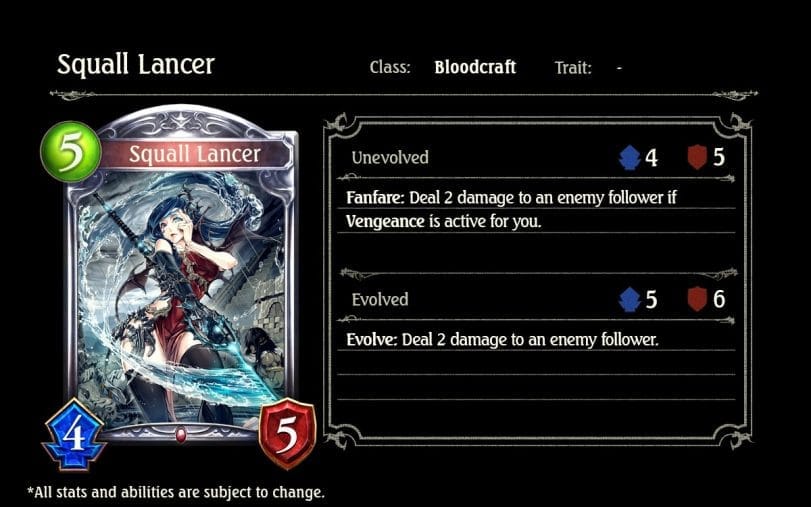
Five points for a 4/5 is about average. As five point play for Bloodcraft, Squall Lancer competes with Erinyes, Bloody Mary and Diabolic Drain, as well as the neutral removals, Execution and Dance of Death. Like the other Bloodcraft specific five point plays, this card is best used in a control Bloodcraft deck, focused on maintaining Vengeance and taking advantage of the cards with Vengeance effects. Like Erinyes and Diabolic Drain, Squall Lancer focuses on reclaiming board presence, and is especially efficient when under Vengeance.
Under ideal conditions, with Vengeance and an Evolution, this card can be as efficient as a three for one trade especially against aggressive decks that swarm the board. While control decks do have a late game advantage versus aggressive decks, this card is a solid mid-game way for Bloodcraft to turn the tides and take control of the board. The Evolve effect is similar to the previously reviews Goblinbreaker Teena's (review here), offering a somewhat minor amount of damage but still making the card only gain +1/+1 from Evolution. This effect is still somewhat underwhelming, but when coupled with the Vengeance effect, means that Squall Lancer can output nine damage to the opponent's board on Evolution, which is a significant amount of damage on turn five.
There is always the inherent risk of being burst down when a Bloodcraft player is in Vengeance range, so fast, board control-oriented plays are always a priority. Squall Lancer definitely offers that, with a very high damage potential and significant board control oriented effects. While a little more situational than Erinyes, Sqaull Lancer is also more targeted and arguably more powerful. Squall Lancer is a great addition to control Bloodcraft's arsenal of Vengeance focused followers, offering a fast, powerful way to swing the board in the player's favor.
Summary: Squall Lancer offers a solid Vengeance effect that can combo with its Evolve effect to be a great board clear. While the Evolve effect itself is somewhat minor, combining it with the card's stats while under Vengeance makes this card great for swinging the board in the Bloodcraft player's favor.
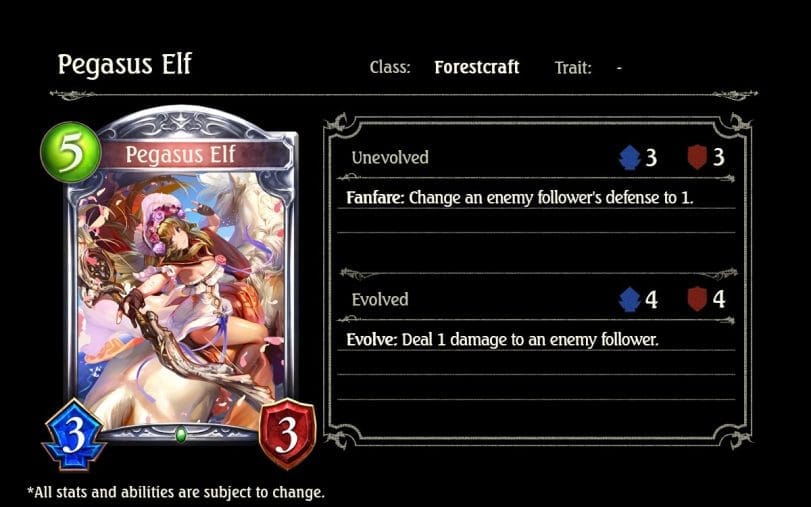
As a five point 3/3, this card is inferior in stats to other five point Forestcraft plays such as Crystalia Tia, Verdant Steward and most of the time to the neutral Wind God, especially when it is played onto a developed board. Pegasus Elf makes up for its inferior stats with a great Fanfare and Evolve effect combo, with the Fanfare being especially significant. Given the ease with which Forestcraft can maintain a board presence of 1/1 Fairies, simply playing Pegasus Elf can be a removal of sorts, changing an opposing follower's defense to one to allow a Fairy to trade into it. This card's Fanfare is identical to the never played Woodkin Curse; subtracting the cost of that from this card makes this card a three point 3/3, which is solid value but doesn't take into consideration the added benefit of being able to play a follower.
Even if played on an empty board, Pegasus Elf is a guaranteed one to one trade, and potentially two for one, if Evolved. The Evolve combos perfectly with the Fanfare to eliminate any one opposing follower without the "Can't be targeted by enemy spells and effects" effect. Admittedly, by itself the Evolve effect is quite weak, and, as with the two damage Evolve effects of abovementioned Squall Lancer and Goblinbreaker Teena, still comes with the Evolution stat boost penalty. This means that, ignoring the effects, Pegasus Elf as a 4/4 may just barely trade with turn four Evolve plays, as many of them tend to be 4/5 in stats. While Pegasus Elf is a somewhat expensive play for a deck that focuses on small follower combos, it can definitely be very helpful against cards such as Goblinmount Demon that turn five combos without prior preparation might find it hard to get past.
As a class without much class specific hard removal beyond the new Crystalia Lily (review here) and Entangling Vines (review here), Pegasus Elf definitely offers unique benefits. Though it is a five point play like most removal cards, it establishes a 3/3 follower on the board and comes with an Evolve effect that can combo well with it. Pegasus Elf is a little expensive for bad stats, so it may not fit into all Forestcraft decks, but its effect of enabling swift removal definitely makes it worth considering.
Summary: Though Pegasus Elf's stats and Evolve effect are both rather bad, the Fanfare serves as a version of removal, especially when coupled with the Evolve effect. It is on the high end of point costs for Forestcraft decks so it hinders combos when it is first played but even so, its strong effects combined with establishing a board presence make it a solid card.
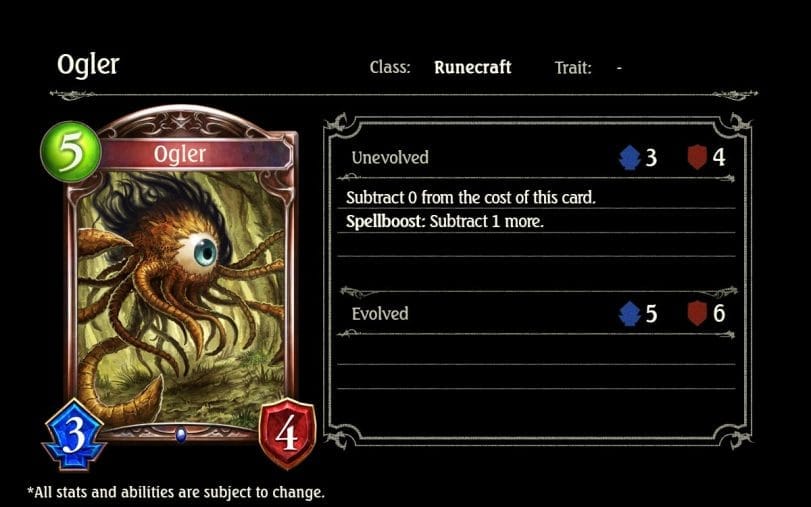
As a five point 3/4 with Spellboost discounts, Ogler can be seen as a direct upgrade to Witchette Emmylou and downgrade from Flame Destroyer, as all cards are overpriced for their stats but offer discounts via the Spellboost mechanisms. While Witchette Emmylou hits is often discounted to zero around turn three, if kept in the opening hand, Ogler seems like it might be at that price about turn four or five. If drawn later, this card does not necessarily need to be discounted to zero to be played, and can also be Spellboosted more by cards such as Sorcery Cache.
Traditionally, Spellboost Runecraft runs few followers, not even Witchette Emmylou, preferring to maintain board control with spells. When playing followers, they will often play them in ways that help with Spellboosting, such as Merlin or Summon Snow. Flame Destroyer is only used as a threat to end games when coupled with Dimension Shift, and, in the midst of these types of cards, it seems that Ogler has no place. However with the new card Daria, Dimensional Witch (review here) which draws and Spellboosts an entire hand by five, this card has the potential to be played for no cost after being drawn, a powerful and immediate way to establish board presence.
3/4 stats are, in general, absolutely average. Unlike Witchette Emmylou, this card will actually be able to hold its own in the later turns of the game, especially with Evolutions, though it still falters versus large late game followers. Ogler takes its place as a Spellboost discount follower between the early game Witchette Emmylou and the game-ending Flame Destroyer, which is an unusual spot but may pave the way for a future Daria, Dimensional Witch deck.
Summary: Ogler has the potential for great value if it gets discounted to zero, which, given its cost, can happen in a reasonable amount of time. Though Spellboost Runecraft does not commonly run followers, with the addition of Daria, Dimensional Witch, this card could definitely see play in a board flooding Daria deck.
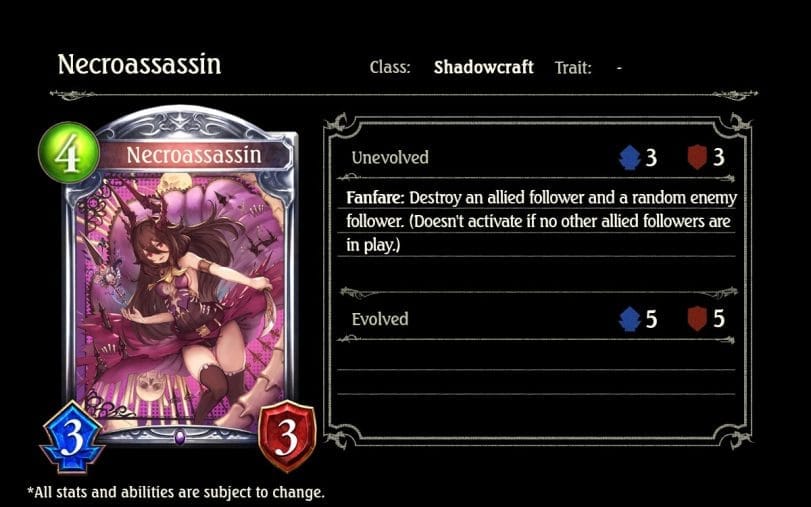
3/3 is slightly below average for a Shadowcraft four point follower, though oftentimes, such stats can be forgiven for good effects. Shadowcraft's other four point plays include Playful Necromancer, Hell's Unleasher, Phantom Howl and Wight King. While they all have their purposes, Necroassassin can also serve a unique purpose, namely board control versus larger followers. The random aspect of Necroassassin's choice of targets is somewhat irritating, but does avoid the "resistance to targeted enemy spells and effects" on some cards such as Aurelia, Regal Saber.
Necroassassin definitely seems geared towards a Last Words deck archetype, perhaps in combination with Nephthys (review here). While destroying some followers, such as Spartoi Soldier, may be less than helpful, triggering other Last Words, such as that of Hell's Unleasher, can really turn the tides. This card offers especially interesting synergies with the newly revealed Lurching Corpse (review here) which allows removal of two opposing followers. This combo costs five points, the same as many one follower removal cards and also establishes a 3/3 on the board, providing a potentially powerful tempo swing.
Even in less than ideal situations, Necroassassin is a rather cheap way to remove an opposing follower, assuming the player has an already developed board. Aggressive decks may appreciate its ability to remove a single large Ward follower with little difficulty, though, since aggressive decks do not always maintain board control, the chances of hitting an unintended target is higher. As Necroassassin herself does not have a Last Words, pulling her out with Nephthys would give no benefit, which decreases her effectiveness in those decks. Necroassassin offers a unique and interesting way for Shadowcraft to take advantage of their Last Words while maintaining board control at the same time; while the current meta does not provide many good Last Words for it to take advantage of, Rise of Bahamut promises quite a few interesting toys to work alongside Necroassassin.
Summary: Necroassassins's unique ability allows it to trade an ally for an enemy. While the randomness of the effect may be annoying, it can potentially be controlled for, especially in control based decks. Given how good some of Shadowcraft's Last Word followers are, especially some of their future options, this card definitely has potential.
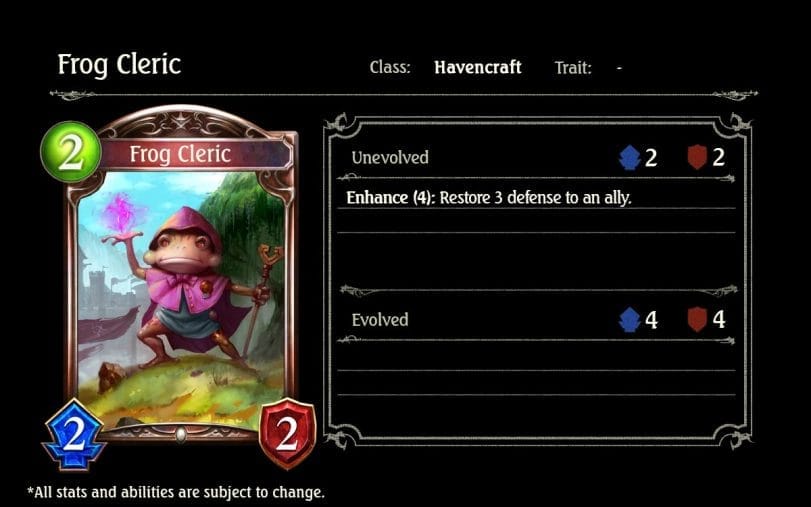
As mentioned in the above review of Luxwing Reno, Havencraft already has its share of great two point drops, such as Beastcall Aria, Mainyu, Snake Priest and Rabbit Healer, making this vanilla two point 2/2 seem somewhat inferior. Granted, Frog Cleric does have an Enhance effect which takes place if this card is played when the player has four or more points available, which restores a significant three defense to an ally. Though Love's Gospel restores three to all allies for only two points, this card also puts a 2/2 on the board. This card could be viewed as a four point 2/5 if all the restore effect lands on a follower, but though those stats are not bad, achieving that is very situational.
More importantly, in the current metagame, healing effects in Havencraft are mostly used to heal the leader for Elana's Prayer. Outside of Curate and Radiance Angel, which both provide significant stats on the board as well as the heal, Elana's Prayer decks thrive on cheaper heals such as Monastic Holy Water to quickly stack Elana's Prayer buffs immediately on followers. Four points is a little too expensive, especially when a card that is one point cheaper, Healing Angel, gives only one less heal but has better stats as well.
The versatility of Frog Cleric's Enhance effect could come in use, as it can both put an allied follower out of range or heal the leader for Elana's Prayer. Most of the time, however, Havencraft would prefer more significant turn four plays, such as Urd for more damage or Priest of the Cudgel for the powerful board control effect. Frog Cleric simply is not powerful enough to be run in what is already one of the more dominant decks in the meta, as it trades efficiency and value for versatility, which is not necessary.
Summary: As a two point follower, Frog Cleric has no effects, which makes it near useless given Havencraft's options. As an Enhance effect follower played with four points, its hard to justify using this card. Though it can heal both the leader or followers on the board, it doesn't offer much in the way of stats or other benefits that make it worth running in the already powerful Elana's Prayer archetype.
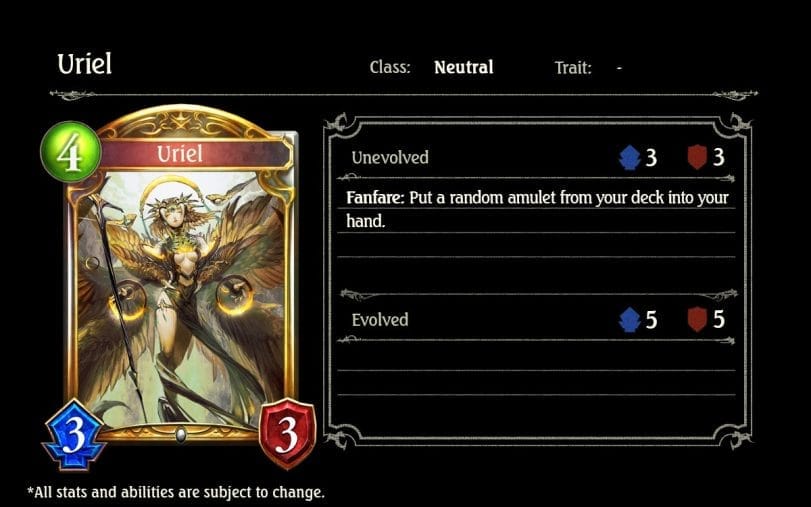
Four points for a 3/3 is slightly below average, but Uriel offers the powerful effect of bringing an amulet from the deck to the hand. Though one might imagine this effect works best in the class with countdown Amulets, Havencraft, that is surprisingly not true. Not only does Havencraft already have a countdown amulet searcher in Prism Priestess, the sheer variety of amulets they run combined with draw power in Sacred Plea means that they will often have enough amulets to work with, and the randomness of Uriel's searching ability does not help very much.
Uriel is more likely to be used in decks that rely on one specific amulet to function fully, such as Path to Purgatory. Other powerful amulets it can search up are Dracomancer's Rites, Midnight Haunt and Juno's Secret Laboratory. Uriel can help make decks that take advantages of amulets like these more reliable. Since Uriel will often be played as soon as possible, it should be noted that the amulet will probably not be played on the same turn as this card, allowing the opponent a little time to prepare and predict.
Still, Uriel will definitely find its way into decks that require a specific amulet to maximize their effectiveness. The recently revealed Dragonclaw Pendant (review here) comes to mind. As a neutral card, this is available to all classes to help them build archetypes focused around a specific amulet, though Havencraft might have trouble making this card reliable. Uriel's trade off of lower stats for an amulet searching effect is definitely worth it for the many decks that require a single, specific amulet to run at full steam.
Summary: Uriel is a great card for decks that need an amulet to do well, for example, discard Dragoncraft archetypes. While it may not be a three of in those kinds of decks, it definitely helps increase reliability and open up the potential for new deck types. Sadly, it may not be very good in the amulet focused class, Havencraft, as it loses a lot of its reliability and simply becomes a slightly overvalued follower.
With the release of Rise of Bahamut just a week away, Cygames is still releasing reveal after reveal on the Shadowverse Twitter and website. This set of reveals has a lot of five point Evolve effect followers, which some classes lacked previously, despite them potentially being an important tempo swing for the player who goes first. Additionally, quite a few of these cards help build up possible future archetypes, especially those based around other previously revealed cards. In about a week, we'll be seeing how well these analyses did; the future metagame of Shadowverse promises to be an interesting place, and hopefully will shake up some of the very established decks that currently exist.
Have a tip, or want to point out something we missed? Leave a Comment or e-mail us at tips@techraptor.net
